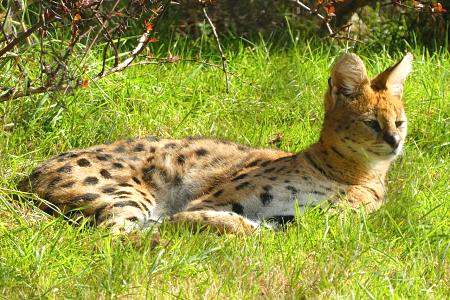Have you ever wondered why drug abuse and the possession of exotic animals appear to be linked so frequently?
“Cocaine Bear” is currently being screened in cinemas, and while it may not be a hit with the critics, it has proven popular enough with audiences to more than double its production budget.
While the film takes some significant creative liberties (which are often exaggerated), it is loosely inspired by actual events. Therefore, it is likely that the filmmakers are now seeking inspiration for a potential sequel.
Allow us to introduce you to “Cocaine Cat,” who may be precisely what they’re searching for.
Although Amiry is a male serval, which is native to sub-Saharan Africa, he currently resides in Ohio, far from his natural habitat.
Cocaine was detected in his bloodstream when he was discovered.
In January, Amiry was rescued from a tree in Cincinnati by HCDW, a branch of CAC. A drug test revealed that the cat had been exposed to narcotics. The serval was not harmed by the drugs, but he broke his leg while fleeing from his rescuers.
He is now in the care of the Cincinnati Zoo, while his former owner faces possible charges of drug possession, animal abuse, and illegal animal importation.
Do you really think Amiry came from Africa to Ohio by himself?

A big cat known as the ‘Leopard’ has been spotted in a tree.
Several people reported seeing a “large exotic cat” or a “leopard” in a tree in the Oakley area of Cincinnati, CAC said on its Facebook. HCDW got these strange reports on January 28.
The beast had eluded the cops, climbed a tree, and was now staying put, according to the reports. HCDW staff members showed up at the scene, obliged to check it out — and surely eager to see what was happening. They soon figured out that the creature in the tree was not a leopard. But it was certainly exotic, so they decided to take the animal with them.
The cat now known as Amiry was discovered to be a feline that’s difficult to catch. The exact events leading up to his rescue are unknown, but it’s clear that he suffered a broken leg during the ordeal.
The injury had a positive side, though. It made Amiry slow enough for the HCDW to catch him before he could get hurt more. They then had one question left.
What specific type of creature was Amiry?
The test result was positive for him.
Amiry was taken to CAC, the parent organization of HCDW. The medical team thought he was an F1 Hybrid Savannah cat. But CAC needed to be sure. So, they contacted a large cat expert — who had previously offered his expertise on the Tiger King case, among others.
The expert glanced at Amiry and said that he’s likely a serval. The long legs, slender neck, and big ol’ ears were unmistakable. CAC wanted to be sure, though, so they did a DNA test. And they also tested Amiry for drugs. If you’re curious why, wait. We’ll explain that.
“Amiry had a positive test for cocaine exposure and the DNA test confirmed he was a serval,” CAC said. Amiry was taken to the Cincinnati Zoo, since the CAC facility could not care for a serval. “His owner was cooperative and covered Amiry’s care costs until all ownership transfers were done, which is when we made this story public,” CAC stated.
The owner did well to pay for their animal’s care. But not so well for letting their drugs be accessible to Amiry — or having Amiry as a pet in the first place.
Servals are not legal to own in Ohio (unlike zebras that bite arms). The investigation is ongoing, but it’s probable the owner will face a bunch of charges.
Too Many Animals on Drugs
Okay, but what made CAC test Amiry for drugs? It’s both funny and tragic that drug tests are now normal procedures whenever the organization handles exotic animals. It’s all because of Neo. He was a capuchin monkey that arrived at CAC in early 2022 and had a positive test for meth.
Animal welfare prosecutors said that the monkey looked like “he’d been in a concentration camp” when he got to CAC. That was the final straw for CAC, and it chose to test any exotic animals for drugs from then on as a protection against their careless druggie owners.
Neo and Amiry have recovered and are now enjoying a healthy and sober life. Let’s wish that CAC can avoid encountering more animals under the influence of drugs in the near future.


